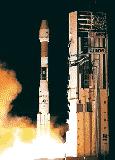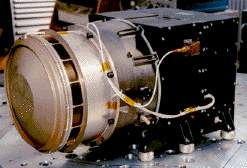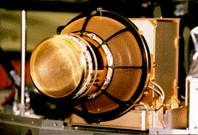

 The Equator-S project is led by the Max-Planck-Institut für extraterrestrische Physik (MPE) and is involved with the Inter-Agency Solar Terrestrial Physics Programme (ISTP).
The Equator-S project is led by the Max-Planck-Institut für extraterrestrische Physik (MPE) and is involved with the Inter-Agency Solar Terrestrial Physics Programme (ISTP).
Equator-S is a low-cost mission designed to study the Earth's equatorial magnetosphere out to distances of 65,000 km. It forms an element of the closely-coordinated fleet of satellites that compromise the ISTP program. It is based on a simple spacecraft design and carries a science payload consisting of advanced instruments that were developed for other ISTP missions. Unique features of Equator-S are its nearly-equatorial orbit and its high spin rate of 40 rotations per minute. It was launched as an auxiliary payload on an Ariane-4 on 2 December 1997. The mission lasted until April 30, 1998. Pictures are available in the Photo Gallery
|
ESIC Information:
|
EDI Information: |
The Equator-S Ion Composition Instrument (ESIC)
 ESIC measures the 3D distribution functions of the major ion species, H, He+, He++, and O+. It consists of a toroidal energy-per-charge (E/q) analyzer with a disk-shaped field of view, followed by a 20 kV post-acceleration into a time-of-flight (TOF) analysis section. The E/q range is 15 V to 40 kV. An optional retarding potential analyzer in the entrance aperture allows the energy range to be extended down to essentially zero volts. To accommodate the large dynamic range in ion fluxes, the instrument has split the 360 deg. FoV into two 180 deg. sections whose sensitivities differ by a factor of 100. Moments of the distributions of all 4 ion species are computed onboard and are available every 4 spins, i.e., every 6 seconds. The instrument is identical to the CODIF portion of the CIS instrument on CLUSTER.
ESIC measures the 3D distribution functions of the major ion species, H, He+, He++, and O+. It consists of a toroidal energy-per-charge (E/q) analyzer with a disk-shaped field of view, followed by a 20 kV post-acceleration into a time-of-flight (TOF) analysis section. The E/q range is 15 V to 40 kV. An optional retarding potential analyzer in the entrance aperture allows the energy range to be extended down to essentially zero volts. To accommodate the large dynamic range in ion fluxes, the instrument has split the 360 deg. FoV into two 180 deg. sections whose sensitivities differ by a factor of 100. Moments of the distributions of all 4 ion species are computed onboard and are available every 4 spins, i.e., every 6 seconds. The instrument is identical to the CODIF portion of the CIS instrument on CLUSTER.
L. Kistler (UNH Durham, USA) is the Lead Investigator. Offsite ESIC Home Page (maintained in Italy)
To learn more, read the instrument description paper, or watch the Time of Flight Detector Movie.
| Date | Event |
|---|---|
| December 2, 1997 | Launch |
| Injection into final orbit | |
| Dec. 15-Jan. 19, 1998 | Instrument Commissioning |
| January 20, 1998 | Beginning of "Routine Operations" with post-acceleration voltage at 15 keV |
| March 3, 1998 | Beginning of High bit rate problem |
| March 19, 1998 | Fixed High bit rate problem |
| March 24, 1998 | Increasing post-acceleration voltage to 18 keV |
The HK and status files are now also available on the web: http://cluster.mpe-garching.mpg.de:2000/EQS/
The Electron Drift Instrument (EDI)
 The electron drift instrument measures the displacement of a weak (< 1 mA) beam of test electrons, after one gyration in the ambient magnetic field, that is induced by electric fields or magnetic gradients. This displacement causes the beam to return to a detector on the spacecraft only when emitted in one of two precisely determined directions. By employing two beams and two detectors, these directions can be monitored continuously and the displacement obtained by triangulation. For small magnetic fields the triangulation degenerates and the displacement is obtained instead from the difference in the travel times of the electrons in the two beams. As a byproduct, the measured times-of-flight provide a precise measurement of the magnetic field magnitude. To separately determine the electric fields and the magnetic field gradients, the electron energy is varied between 1.0 and 0.5 keV. Time-resolution varies with ambient conditions, but should typically be 100 ms or better. The electron drift instrument on EQUATOR-S is identical to the instrument developed for CLUSTER.
The electron drift instrument measures the displacement of a weak (< 1 mA) beam of test electrons, after one gyration in the ambient magnetic field, that is induced by electric fields or magnetic gradients. This displacement causes the beam to return to a detector on the spacecraft only when emitted in one of two precisely determined directions. By employing two beams and two detectors, these directions can be monitored continuously and the displacement obtained by triangulation. For small magnetic fields the triangulation degenerates and the displacement is obtained instead from the difference in the travel times of the electrons in the two beams. As a byproduct, the measured times-of-flight provide a precise measurement of the magnetic field magnitude. To separately determine the electric fields and the magnetic field gradients, the electron energy is varied between 1.0 and 0.5 keV. Time-resolution varies with ambient conditions, but should typically be 100 ms or better. The electron drift instrument on EQUATOR-S is identical to the instrument developed for CLUSTER.
G. Paschmann (MPE Garching, Germany) is the Lead Investigator.
More detailed information on EDI is also available.